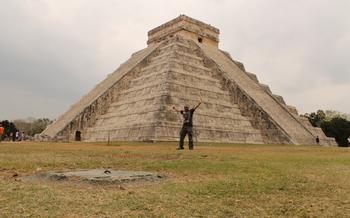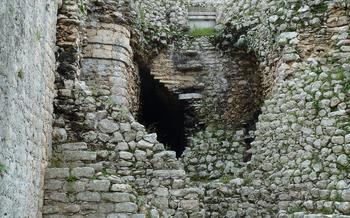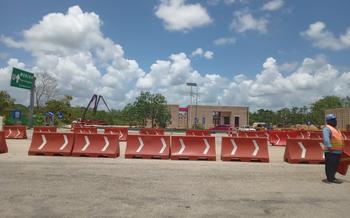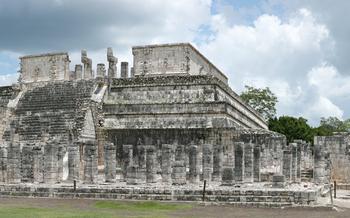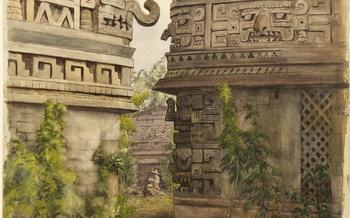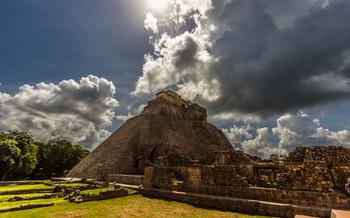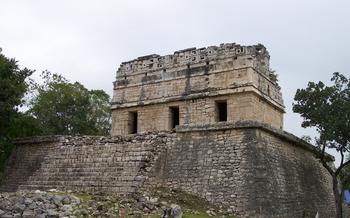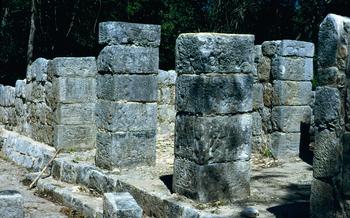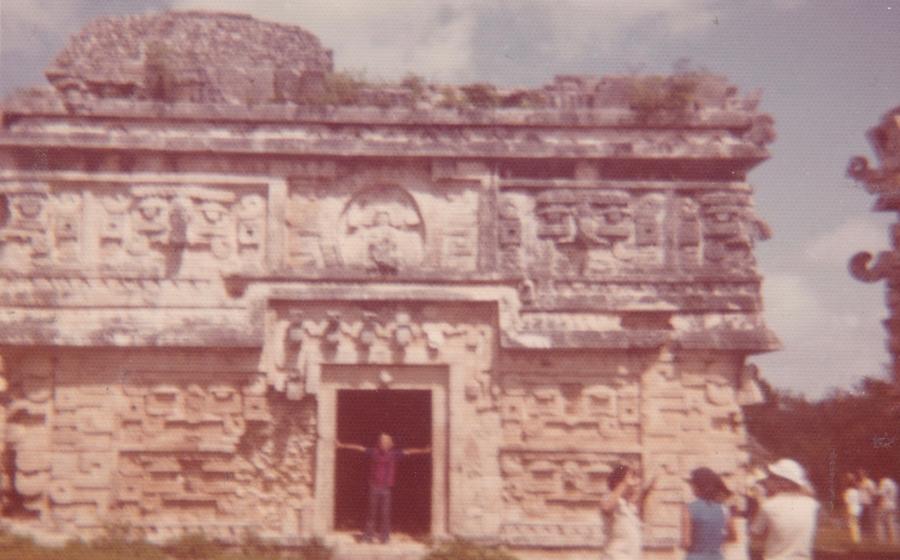
The Nunnery Annex
- The Nunnery Annex: An Enigmatic Complex
- Location and Accessibility
- History and Significance
- Architectural Highlights
- Theories About Its Purpose
- Archaeological Discoveries
- Religious Significance
- Cultural Significance
- Visiting Tips
- Photography and Videography
- Guided Tours and Local Guides
- Nearby Attractions
- Safety and Precautions
- Insider Tip: Unveiling the Secrets
The Nunnery Annex: An Enigmatic Complex
The Nunnery Annex, an intriguing complex within the ancient city of Chichen Itza, draws the attention of travelers with its enigmatic aura. It is a complex of buildings located to the north of the Great Ball Court and is one of the most important structures in the city. The complex is believed to date back to the 10th century AD and was constructed during the Terminal Classic period. Its construction exhibits the architectural prowess of the Maya civilization and is adorned with intricate carvings and symbolism. The origin of its name, "The Nunnery," arose from the erroneous assumption by early explorers that it was a convent for female religious figures. Theories surrounding its true purpose range from serving as a religious center or administrative quarters to being used for astronomical observations. One of its most notable features is the Red House, which displays a significant number of red handprints on its walls, symbolizing power and authority.
Location and Accessibility
The Nunnery Annex is situated approximately 5 kilometers east of the main Chichen Itza complex, making it easily accessible on foot or by bicycle. For those arriving by car, ample parking is available near the main entrance. Visitors can opt for guided tours, which often include transportation to and from the site, or explore independently at their own pace. Guided tours offer the advantage of insights from knowledgeable guides who can provide historical context and point out important features. However, self-guided exploration allows for a more leisurely and intimate experience, enabling visitors to wander through the ruins at their leisure and capture stunning photographs.
History and Significance
The Nunnery Annex dates back to the Terminal Classic period (800-1000 AD), a time of significant cultural and political transformation in the Maya world. It was constructed during the reign of the powerful Maya ruler K'ak'upacal, who is believed to have commissioned the construction of several other important buildings in Chichen Itza. The complex was continuously occupied and modified throughout the Terminal Classic period, indicating its enduring importance to the Maya elite.
Archaeological evidence suggests that the Nunnery Annex played a significant role in religious ceremonies and rituals. Altars, offerings, and other sacred objects have been found within the complex, indicating that it was a place of worship and devotion. The presence of large, open plazas and courtyards suggests that it was also used for public gatherings and community events.
The Nunnery Annex is a valuable site for understanding the history and culture of the Maya people. It provides insights into their religious beliefs and practices, their political organization, and their daily lives. The site's well-preserved architecture and artifacts offer a glimpse into the world of the ancient Maya, making it a must-visit destination for anyone interested in Mesoamerican history and culture.
Architectural Highlights
The Nunnery Annex showcases a blend of unique architectural elements that reflect the cultural influences of the Maya and other Mesoamerican civilizations. The complex features various types of buildings, including temples, palaces, platforms, and residential structures. Each structure exhibits distinct architectural features, such as corbelled arches, intricate carvings, and colorful murals.
One notable feature of the Nunnery Annex is the Red House, a two-story building that stands out with its vibrant red paint. Its walls are adorned with intricate bas-reliefs depicting scenes from Maya mythology and daily life. Another significant structure is the Temple of the Initial Series, which features a hieroglyphic stairway and a well-preserved lintel depicting a Maya ruler.
The architectural style of the Nunnery Annex exhibits influences from both the Maya and Central Mexican cultures. The corbelled arches and the use of red paint are characteristic of Maya architecture, while the presence of talud-tablero facades and colonnaded galleries suggests Central Mexican influence. These architectural features create a harmonious blend that reflects the cultural diversity of the ancient Maya civilization.
Overall, the Nunnery Annex is a treasure trove of architectural wonders that offers insights into the diverse cultural influences that shaped the Maya civilization.
Theories About Its Purpose
The exact purpose of the Nunnery Annex remains a subject of debate among archaeologists and historians. Various theories have been proposed based on the site's layout, architectural features, and artifacts found during excavations.
One of the most prevalent theories suggests that the complex served primarily religious functions. The presence of temples, altars, and other ritual spaces indicates that it may have been a place of worship or pilgrimage. The Red House, in particular, is believed to have been a temple dedicated to the Maya rain god, Chaac.
Another theory proposes that the Nunnery Annex was an administrative or residential complex. The presence of several well-preserved structures, including the Temple of the Initial Series, suggests that it may have housed Maya rulers or other high-ranking officials. The complex's proximity to the main ceremonial center of Chichen Itza also supports this theory.
A third theory suggests that the Nunnery Annex may have served as an astronomical observatory or calendar system. The complex's alignment with the cardinal directions and the presence of several structures with windows or doorways that align with celestial events have led some to believe that it was used for astronomical observations and timekeeping.
It is also possible that the Nunnery Annex served a multifunctional purpose, combining religious, administrative, and astronomical functions. The complex's diverse architectural features and the variety of artifacts found at the site support this theory.
Further research and archaeological excavations are needed to shed more light on the exact purpose of the Nunnery Annex. However, the various theories that have been proposed offer intriguing possibilities and contribute to our understanding of this enigmatic site.
Archaeological Discoveries
Excavations at the Nunnery Annex have yielded a wealth of artifacts and inscriptions that shed light on Maya culture and daily life. Archaeologists have uncovered ceramic vessels, stone tools, and intricate carvings that provide glimpses into the practices and rituals that took place within the complex. Inscriptions on the buildings and stelae have also been instrumental in deciphering the Maya writing system and understanding the historical significance of the site.
The most notable discovery at the Nunnery Annex is the Temple of the Initial Series, which contains a series of hieroglyphs that record the earliest known Maya Long Count date. This discovery has been crucial in establishing a timeline for Maya history and understanding the development of their calendar system.
Ongoing research and new findings at the Nunnery Annex continue to contribute to our knowledge of Maya culture. Archaeologists are constantly uncovering new artifacts and inscriptions that help us piece together the puzzle of this ancient civilization.
Religious Significance
The Nunnery Annex holds deep religious significance for the ancient Maya people. It is believed to have been a sacred space dedicated to religious ceremonies and rituals. Evidence of this can be found in the presence of altars, offerings, and other sacred objects found throughout the complex.
The site is closely associated with the Maya deities, particularly the rain god Chaac. Depictions of Chaac and other deities can be found in the carvings and iconography that adorn the buildings. This suggests that the complex may have been used for rituals related to agriculture and fertility, which were vital to the survival of the Maya people.
The Nunnery Annex's connection to the broader Mesoamerican belief system is also evident in its layout and architecture. The site features plazas, temples, and other structures that are typical of Maya religious complexes throughout the region. This suggests that the Maya who built and used the Nunnery Annex were part of a larger cultural and religious network that spanned the ancient Mesoamerican world.
Cultural Significance
The Nunnery Annex holds immense cultural significance as a symbol of Maya heritage and a source of pride for the contemporary Maya people. It serves as a testament to the ingenuity, artistry, and religious beliefs of the ancient Maya civilization. The site plays a crucial role in preserving and revitalizing Maya culture, as it provides valuable insights into their history, traditions, and worldview. Efforts are continuously made to protect and promote the cultural significance of the Nunnery Annex, ensuring its legacy is preserved for future generations. Visitors are encouraged to respect the cultural importance of the site and contribute to its ongoing preservation by adhering to guidelines and refraining from causing any damage or disruption.
Visiting Tips
To make the most of your visit to the Nunnery Annex, keep these tips in mind:
-
Timing is key: Aim to visit during the shoulder seasons (May-June and September-October) to avoid the peak tourist crowds. The weather is generally pleasant during these months, with fewer chances of rain.
-
Plan your duration: Allocate at least an hour to explore the Nunnery Annex thoroughly. This will give you enough time to admire the architectural details, read the information panels, and soak in the atmosphere.
-
Pack essentials: Bring comfortable walking shoes, sunglasses, a hat, and sunscreen to protect yourself from the tropical sun. A camera is a must to capture the stunning visuals. Consider bringing binoculars for a closer look at the intricate carvings and sculptures.
-
Respect the site: Remember that the Nunnery Annex is a sacred place for the Maya people. Be respectful of their cultural heritage by refraining from touching or climbing on the structures. Stay on designated paths and avoid disturbing the wildlife.
Photography and Videography
The Nunnery Annex offers a treasure trove of photographic opportunities, capturing the essence of its ancient architecture, intricate carvings, and the surrounding natural beauty. Here are some tips for capturing the best shots:
-
Composition: Experiment with different angles and perspectives to create visually appealing compositions. The site's unique structures and lush vegetation provide endless possibilities for creative shots.
-
Lighting: The golden hour, just after sunrise or before sunset, casts a warm and magical glow on the ruins, enhancing their beauty. Take advantage of this natural lighting to capture stunning images.
-
Equipment: While a smartphone camera can capture decent shots, consider bringing a DSLR or mirrorless camera with a wide-angle lens to capture the expansive views. A tripod can also be useful for stability and long exposure shots.
-
Respect the Site: Remember that the Nunnery Annex is a sacred and historical site. Be mindful of other visitors and avoid obstructing their views or disturbing the tranquility of the environment.
Guided Tours and Local Guides
Booking a guided tour for your exploration of the Nunnery Annex is a worthwhile investment. A knowledgeable guide can provide insights into the complex's history, symbolism, and cultural significance that you might miss if exploring independently. Choose a reputable tour operator with experienced and certified guides who are passionate about sharing their expertise. Interacting with local guides not only enhances your understanding of the site but also supports the local economy and community. They can share personal stories and anecdotes, giving you a deeper connection to the place and its people. Remember to ask questions, engage in conversations, and show appreciation for their knowledge and guidance.
Nearby Attractions
Chichen Itza offers a wealth of attractions beyond the Nunnery Annex. The Great Ball Court is one of the largest and most impressive in the Maya world, showcasing the significance of the game in Maya culture. The Temple of Kukulcan, also known as El Castillo, is an iconic pyramid that dominates the site, showcasing intricate carvings and serving as the stage for the famous spring and autumn equinox light-and-shadow phenomenon.
Cenotes, or natural sinkholes, are another highlight of the region. Ik Kil and Xcajum are two popular cenotes offering swimming and snorkeling opportunities in crystal-clear waters surrounded by lush vegetation.
For a glimpse into Maya culture and traditions, visit the nearby village of Pisté. Here, you can interact with local artisans, sample traditional Maya cuisine, and learn about the community's customs and history.
To plan a comprehensive visit, consider spending at least two days in Chichen Itza, allowing ample time to explore the various sites, immerse yourself in the culture, and relax in the natural beauty of the region.
Safety and Precautions
Chichen Itza is generally a safe destination for tourists, but it's essential to exercise caution as you would in any unfamiliar place. Be aware of your surroundings, keep an eye on your belongings, and avoid walking alone at night. It's advisable to exchange currency at official exchange bureaus and use ATMs located inside banks or reputable establishments. Respect local customs and traditions, dress appropriately, and refrain from taking photographs of people without their permission. Stay informed about any travel advisories issued by your government or reputable travel organizations. By following these precautions, you can ensure a safe and enjoyable visit to Chichen Itza.
Insider Tip: Unveiling the Secrets
To fully immerse yourself in the enigmas of the Nunnery Annex, consider embarking on your exploration early in the morning or late in the afternoon. The serene ambiance during these times offers a unique opportunity for introspection and connection with the ancient spirits that inhabit the site. Venture beyond the main paths to discover hidden corners and secluded chambers, where you might stumble upon enigmatic carvings or uncover clues that have eluded archaeologists for centuries. Engage with local historians or archaeologists who can provide invaluable insights into the site's history, symbolism, and ongoing research. Their expertise will unlock the secrets of the Nunnery Annex, leaving you with a profound understanding of this captivating Maya masterpiece.
